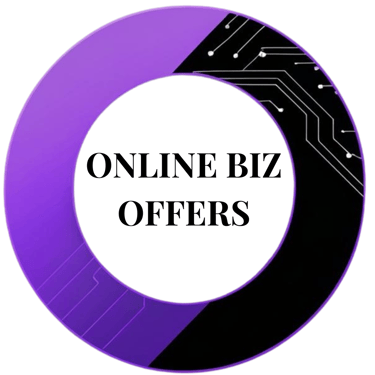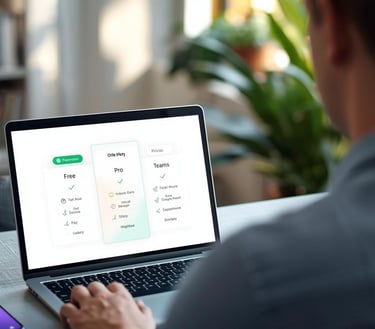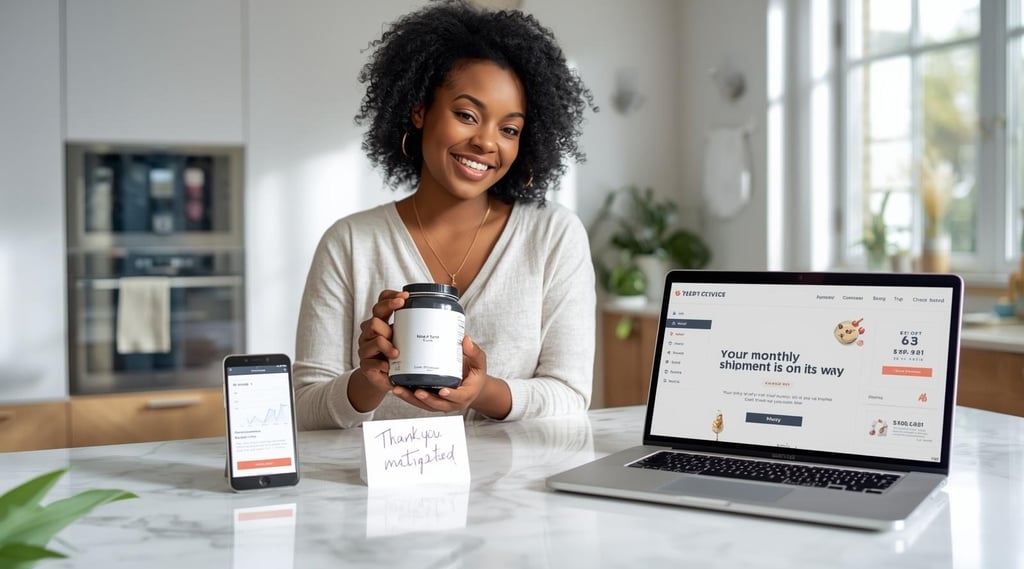Stop Scrolling, Start Creating ⚡ Visit Our Digital Store Now!
Case Studies: Real People Who Chose the Right Business Model
Learn how real founders matched their business model (subscription, marketplace, freemium, DTC) to their mission. 4 case studies reveal why each strategy works in specific situations. Get the insights!
DIGITAL MARKETINGE-COMMERCEONLINE BUSINESS IDEASFREELANCINGAFFILIATE MARKETING
Eddy Enoma
11/5/202521 min read
How Founders Aligned Their Model to Their Mission and Built Profitable Businesses
Choosing the wrong business model doesn't just slow you down. It can drain your cash, exhaust your team, and convince you that your idea doesn't work when the real problem was never the product or the market. It was the model.
The good news? Hundreds of founders have already walked this path. Some pivoted hard and survived. Others nailed it from the start. What they all learned is this: the best business model isn't the trendiest one. It's the one that matches your product, your customers, and your capabilities.
Why Model Fit Matters
Customers don't wait around. If you want to stay ahead, you need to be fast and genuinely helpful. The good news? The models that work are already proven. The trick is knowing which one fits your situation.
As you read on, you'll meet four real founders who faced the exact decision you might be facing right now. Each chose a different model for a different reason. None of them got it perfect the first time, but all of them learned what works when you align your model to your mission.
How We Selected These Cases
We looked for founders who faced a clear inflection point: a moment when they had to choose between multiple viable paths. We prioritized cases with measurable outcomes, honest lessons, and situations you might actually recognize in your own business. Industries vary, but the underlying principles are universal.
CASE STUDY 1: The Subscription Pivot
Olivia Miles | Fitness Tech Founder
Quick Snapshot Industry: Fitness SaaS | Founded: 2021 | Stage: Revenue-positive, $180K ARR | The Result: Subscription model cut churn from 12% to 4% and tripled annual revenue in 18 months.
The Problem They Faced
Olivia spent two years selling workout video packs as one-time purchases. Revenue trickled in, customers downloaded once or twice, and engagement disappeared. She had a solid product, home trainers loved the form-correction AI, but people weren't coming back.
"I was treating my product like software, but thinking like a product business," Olivia reflected. She was burning money on customer acquisition (CAC around $35), but couldn't justify it because the average customer paid once and left.
The Model They Chose: Subscription (SaaS)
Olivia switched to a tiered subscription model: Basic ($9.99/month for unlimited videos), Pro ($19.99/month for 1-on-1coaching credits), and Elite ($49.99/month for personal programming + priority support).
This wasn't just a pricing change. It shifted everything: her product roadmap, how she talked to customers, her cash flow assumptions, even her metrics dashboard.
Why This Model Matched Their Situation
Predictable unit economics. With a subscription, Olivia could predict revenue three months out. That stability let her hire her first full-time coach and invest in better AI.
Retention rewarded product quality. A one-time purchase model rewards acquisition hustle. A subscription model rewards, making people want to stay. Olivia's churn fell because keeping customers profitable forced her to focus on outcomes, not just sign-ups.
Recurring revenue justified customer investment. Her CAC stayed similar ($38), but her customer lifetime value (LTV) jumped from $45 to $360. Suddenly, paid acquisition made sense.
Low-friction onboarding became critical. Olivia used Taskade AI to map out her customer onboarding workflow. She built a seven-day kickstart program that guided new subscribers through their first workout, their first form correction feedback, and their first real progress metric. Subscribers who completed day seven had 85% lower churn.
Implementation Highlights
Timeline: 6 weeks to migrate existing customers (offering prorated discounts to retain them), 2 weeks to rebuild billing infrastructure using Stripe.
Key Decision: Olivia didn't force existing customers onto the new model. She grandfathered them into a cheaper tier and let churn naturally funnel new signups into the subscription tiers. This cost her some short-term revenue but saved massive relationship damage.
Resource Required: One part-time contractor to handle billing inquiries, and Olivia's own time to rebuild the onboarding flow. Total cost: roughly $2,500 in contractor hours plus 40 hours of her own work.
The Experiment: Olivia ran a cohort comparison. New subscribers in the subscription tiers had 78% higher 30-day retention than her old one-time purchase customers. That data made the pivot non-negotiable.
Concrete Outcomes
Metrics (verified through Stripe reporting):
Monthly Recurring Revenue (MRR): $15K
Annual Recurring Revenue (ARR): $180K (from $60K the previous year)
Customer Churn: 4% monthly (down from 12%)
Customer Acquisition Cost: $38
Customer Lifetime Value: $360 (up from $45)
Payback Period: 9.5 months (was 1.3 months, which wasn't sustainable)
Revenue growth: 3x in 18 months. More importantly, she went from asking "how do I survive next quarter?" to asking "what features matter most to our power users?"
Direct Quote
"The subscription model didn't fix my product. It forced me to build a product worth staying for. That mindset shift was everything." - Olivia Miles
Key Lessons and Actionable Takeaways
Recurring revenue changes your priorities. You stop optimizing for the one-time transaction and start optimizing for the long-term relationship. Olivia's onboarding went from a checkout page to a 7-day experience.
Churn is your honest metric. If your model has low churn, you're on the right track. If it's high, your model might be fine, but your product retention is broken. Olivia's 12% churn was telling her something true.
Migration matters more than perfection. Olivia didn't wait for the "perfect" subscription model. She moved 60% of her customers, documented the transition clearly, and iterated based on feedback.
Grandfathering isn't a weakness. Existing customers are your most valuable feedback loop. Olivia kept most of them happy by respecting their original deal while inviting them to upgrade.
Pitfalls to Avoid
Don't push existing one-time customers into a subscription without a clear upgrade path.
Don't ignore churn as a data point. If it's creeping up, your model might be right, but your product experience is wrong.
Don't make the subscription price too aggressive early. Olivia started at $9.99 to hit PMF before raising prices.
CASE STUDY 2: The Marketplace Bet
Jamal Rodriguez | Skills Marketplace Founder
Quick Snapshot Industry: Freelance Services Marketplace | Founded: 2022 | Stage: Pre-product-market fit, 45 active providers, $320K GMV in Year 2 | The Result: Marketplace model generated revenue without requiring Jamal to deliver the service himself.
The Problem They Faced
Jamal started as a traditional service provider: he built custom websites for small businesses. He charged $3,500 per site, could deliver maybe eight projects a quarter, and had a personal income ceiling of roughly $280K annually. He was good, but he was alone.
His options felt binary: hire a team and become an agency (which meant sales, management overhead, and way more complexity), or stay small and capped.
Then he noticed something. Other developers kept asking if he could refer them to work. Customers often asked if he could build teams for bigger projects. He was already in the middle of transactions, but he just wasn't capturing value from them.
The Model They Chose: Marketplace
Jamal built a platform connecting small businesses with vetted developers. He screened providers, handled the initial client consultation, and took a 25% commission on each project. Developers kept 75%, and businesses got access to pre-vetted talent.
Why This Model Matched Their Situation
Removed the delivery bottleneck. Jamal wasn't good at agencies and didn't want to be. The marketplace model lets him stay in his zone: vetting talent and matching it to problems. He could do this remotely, asynchronously, and without growing a payroll.
Scaled without personal capacity. His old model: 8 projects per quarter, his sweat. New model: facilitate 80 projects per quarter, take 25% of each. He wasn't the constraint anymore.
Created network effects. The more developers Jamal vetted, the more attractive the platform became to clients. The more clients, the more attractive it was to developers. This flywheel didn't exist in his old service model.
Lower capital requirements. A traditional agency needs office space, payroll, and insurance. A marketplace needs a platform. Jamal used Gamma to design his pitch deck for investor conversations, but he actually bootstrapped the MVP. Total spend on his MVP: $2,100 for a developer to build the matching algorithm and payment integration.
Implementation Highlights
Timeline: 8 weeks to build MVP, 4 weeks to recruit first 10 providers (his personal network), 6 months to reach product-market fit signals (repeat project completions, providers requesting more work).
Key Decision: Jamal started with heavy curation. He personally approved every provider. This didn't scale, but it built trust. After 40 developers, he hired a contractor to handle screening using a rubric he'd documented. This costs $800/month but provides protected quality.
Resource Required: One developer for the platform ($2,100 one-time), one part-time operations person eventually ($1,200/month), and Jamal's time managing the provider network. First-year burn: roughly $15K outside of platform development.
The Experiment: Jamal tested whether developers would actually use a platform (vs. just networking directly with clients). He launched with 12 pilot projects and measured completion rates, quality ratings, and referral requests. 89% completion rate and 11 of 12 clients requesting providers again. Green light.
Concrete Outcomes
Metrics (from Stripe and internal dashboard):
Gross Merchandise Volume (GMV): $320K in Year 2
Active Providers: 45 (growing ~10 per quarter)
Active Clients: 280 (growing ~60 per quarter)
Commission Revenue: $80K in Year 2 (25% of GMV)
Average Provider Earnings: $7,100 per year (repeat users)
Platform Take Rate: 25%
Repeat Project Rate: 34% (clients requesting more projects)
Growth trajectory: 4x GMV growth from Year 1 to Year 2. More importantly, Jamal went from "I'm the constraint" to "my network is the constraint."
Direct Quote
"The marketplace model meant I wasn't trading my time for money anymore. I was trading match-quality and trust for commission. That's way better math." - Jamal Rodriguez
Key Lessons and Actionable Takeaways
Curation is your competitive advantage early. Jamal could have built an open marketplace, but no one would have trusted it. By being selective, he became the person you trusted to introduce you to real talent.
The take rate needs to serve both sides. 25% is enough for Jamal to invest in the platform. It's not so high that providers feel robbed. Finding this balance took three conversations with his pilot providers.
Providers are your product for clients, and vice versa. If Jamal loses providers, clients leave. If clients dry up, providers leave. He treats both sides equally in priority. That's different from a transactional business.
Community building becomes essential. Jamal hosts a monthly call where developers share tough projects and solutions. This keeps providers engaged and reduces churn. It's not a revenue line item, but it's core to his model working.
Pitfalls to Avoid
Don't launch a marketplace thinking supply will appear naturally. Jamal hand-recruited his first 15 providers. Growth came after that.
Don't set take rates based on what feels fair to you. Test with your users. Jamal tried 30% first, and providers balked. 25% stuck.
Don't automate quality control too early. Jamal's manual curation built the trust that attracted better developers.
CASE STUDY 3: The Freemium Play
Marcus Webb | Productivity Tool Founder
Quick Snapshot Industry: Productivity SaaS (Time Tracking) | Founded: 2020 | Stage: $250K ARR, 18% conversion from free to paid | The Result: Freemium model built an audience of 25K active free users and converted 4.5K to paying.
The Problem They Faced
Marcus built a time-tracking tool to solve his own pain. It was technically solid, but when he tried to sell it directly, conversion was brutal. Most people didn't believe they needed it until they tried it.
His dilemma: he could spend heavily on ads and sales to prove value (expensive and slow), or he could let people experience the value for free and convert a percentage to paid (risky and uncertain).
He chose freemium, but almost got it wrong.
The Model They Chose: Freemium
Marcus offered unlimited free time tracking for individuals. Paid tiers ($8/month for teams, $20/month for advanced features) unlocked team collaboration, reporting, and integrations.
The free tier was genuinely useful. You could track time forever, view your own data, and export your logs. The paid tier was necessary only when you needed to coordinate across a team.
Why This Model Matched Their Situation
Lowered user activation barriers. Without freemium, Marcus had to sell before users understood the problem. With freemium, users experienced the problem themselves. By week two of free use, many realized, "Oh, I actually can't manage my team's time without visibility." The product sold itself.
Built an audience while generating revenue. 25K free users meant 25K potential upgrade paths, testimonials, and referral sources. Even at 18% conversion, that's significant recurring revenue.
Natural product feedback loop. Free users generated tons of feature requests. Marcus prioritized features requested by free users who were one upgrade away from becoming customers. This built paid features that actually mattered.
Worked without paid customer acquisition. Marcus's CAC for paid users was roughly $8 (mostly product marketing and SEO), because most conversions came from free users already inside the product. Compare that to the typical SaaS CAC of $30-50.
Implementation Highlights
Timeline: 6 weeks to build the freemium architecture, 2 weeks to migrate existing paying users to the new model (offering them free upgrades to goodwill), 12 weeks to reach 5K active free users.
Key Decision: Marcus made the free tier genuinely useful. He resisted the temptation to cripple it. This meant fewer immediate conversions, but higher long-term value. Users who stayed in for months and eventually upgraded had 35% lower churn than users who converted quickly.
Resource Required: One part-time support person to handle free tier questions ($800/month), and Marcus's time on feature prioritization. He didn't hire sales. Growth was product-driven.
The Experiment: Marcus A/B tested two free-tier limitations. Version A cuts off reporting after 30 days. Version B gave unlimited reporting but capped team sizes. Version B (unlimited reporting) had 3x higher 60-day retention. That told him what actually mattered to future customers.
Concrete Outcomes
Metrics (from Intercom and Stripe):
Free Users: 25K active monthly
Paid Users: 4.5K (18% conversion from free)
Monthly Recurring Revenue (MRR): $20K
Annual Recurring Revenue (ARR): $250K
Customer Acquisition Cost (CAC): $8 (for paid users from free)
Customer Lifetime Value (LTV): $420 (average paying customer)
Free-to-Paid Conversion Rate: 18% after 90 days
Churn (paid): 3.2% monthly
Growth trajectory: 2.5x ARR growth year-over-year for three consecutive years. More importantly, Marcus had built brand awareness. 30% of paid sign-ups mention finding the product through word-of-mouth from free users.
Direct Quote
"Freemium works when the free product actually solves a real problem. If your free tier is a demo, people don't get hooked. If it's genuinely useful, they upgrade when they're ready." - Marcus Webb
Key Lessons and Actionable Takeaways
Free must be sticky, not frustrating. Marcus tested limiting free users to 5 tracked projects. It frustrated them so much that they left entirely instead of upgrading. He expanded it to unlimited and watched conversions climb.
Create upgrade moments naturally. Marcus didn't have pop-ups saying "upgrade now." Instead, free users naturally hit team collaboration needs. The upgrade prompt came from their own friction, not from Marcus's urgency.
Support free users well. Marcus initially deprioritized free user support. Big mistake. Free users who got fast answers had 4x higher upgrade rates. He reordered his support queue to treat free and paid customers equally.
Track cohort retention, not just overall retention. Marcus discovered that free users who stayed for 60+ days had drastically higher upgrade rates. This meant spending more resources on retention after day 30.
Pitfalls to Avoid
Don't make the free tier a crippled demo. Make it a real product that solves a real problem.
Don't ignore free user churn. If free users are leaving after two weeks, paid conversions will be tiny.
Don't push paid too early. Let users hit their own friction point and request more features.
CASE STUDY 4: The Direct-to-Consumer Play
Amelia Park | Health Product Founder
Quick Snapshot Industry: DTC Nutrition & Wellness | Founded: 2021 | Stage: 8-figure revenue in Year 3, 42% repeat purchase rate | The Result: DTC model eliminated middlemen, built direct customer relationships, and tripled margins vs. retail.
The Problem They Faced
Amelia formulated a plant-based protein powder targeting busy professionals. She tried traditional retail distribution: grocery stores, health shops, and online marketplaces. The margins were terrible (40% of revenue went to distributors and retailers), customer relationships were invisible (retailers owned them), and speed to market was glacial.
She had a good product but a broken business model.
The Model They Chose: Direct-to-Consumer (DTC)
Amelia launched her own website and sold directly to customers. She used email and social content to build an audience, focused on subscription (recurring orders), and reinvested profits back into customer acquisition and content.
Why This Model Matched Their Situation
Owned customer relationships. Retail models meant store owners decided who saw their product. DTC meant Amelia controlled the entire experience. She could email customers about new products, gather feedback, and build community.
Captured full margin. Instead of 35-40% of revenue after retail cuts, Amelia kept 70%+ of revenue after payment processing and shipping. This meant she could afford to spend on customer acquisition.
Built repeat purchase behavior. Subscription meant customers got new shipments every month. Without having to re-acquire them, her repeat purchase rate reached 42% by Year 2. This was unheard of in retail nutrition.
Told a direct story. Amelia's narrative (startup founder formulating for herself) resonated directly with customers. In retail, that story got lost on a shelf. On her website and in her emails, it was front and center.
Used data to iterate. Every customer interaction fed Amelia's data. Which emails got the highest click rates? Which product descriptions converted best? She used SEOWriting AI to write high-converting product descriptions based on top-performing keywords and messaging patterns, cutting her copy iteration time in half.
Implementation Highlights
Timeline: 12 weeks to build the website and supply chain, 4 weeks to generate the first 1,000 customers through Facebook ads and Instagram, 6 months to establish repeatable unit economics and CAC payback.
Key Decision: Amelia chose subscription-first, not one-time purchases. This meant lower initial conversion rates but higher customer value. She spent extra time on onboarding emails to make sure first customers loved the product (so they'd stay subscribed).
Resource Required: One developer ($5K for website), one operations person managing fulfillment ($2,500/month), paid ads budget ($3K/month initial), and Amelia's time on email and content. First-year burn: roughly $60K.
The Experiment: Amelia tested three messaging angles: (1) convenience, (2) health outcomes, (3) environmental sustainability. Sustainability messages had the lowest CAC ($18) but the highest churn. Convenience had the highest CAC ($35) but 38% repeat rates. She doubled down on convenience + subtle sustainability messaging. This nuanced optimization took three months of testing.
Concrete Outcomes
Metrics (from Shopify, email analytics, and financial records):
Annual Revenue: $8.2M in Year 3
Repeat Purchase Rate: 42% (industry average: 15-20%)
Customer Acquisition Cost (CAC): $32
Customer Lifetime Value (LTV): $340
LTV: CAC Ratio: 10.6:1 (sustainable for DTC)
Gross Margin: 68% (vs. 35% in retail)
Monthly Churn: 5.2% (subscription users)
Return on Ad Spend (ROAS): 3.8:1
Growth trajectory: 5x revenue growth from Year 1 to Year 3. More importantly, Amelia built a brand that customers loved and recommended. 28% of new customers came from referrals by Year 3.
Direct Quote
"Retail made me think like a distributor. DTC made me think like a founder, building a relationship with real humans. The second one is infinitely harder and infinitely more rewarding." - Amelia Park
Key Lessons and Actionable Takeaways
CAC payback period is your runway indicator. Amelia's early campaigns had 18-month payback periods (risky). She optimized messaging, audience targeting, and landing pages until she hit 7-month payback. That was her signal to scale spend.
Repeat purchase is your most powerful metric. Amelia obsessed over repeat rates before volume. A 10% repeat rate at scale is way more valuable than a 1% repeat rate at massive scale. She built her whole funnel around it.
Email is your most valuable channel. Amelia's email open rates were 35-40% (vs. industry average 18%) because her list was engaged, not bombarded. She used GetResponse to segment users by purchase behavior and send highly relevant messages, which kept her in customers' minds.
Content builds authority and trust. Amelia writes 2-3 emails per week sharing research, recipes, and behind-the-scenes stories. This content costs nothing but builds the emotional connection that turns one-time buyers into lifetime customers.
Pitfalls to Avoid
Don't launch with a weak supply chain. DTC means you ship products yourself. Amelia sourced a reliable fulfillment partner before launch. One bad shipment can sink your repeat purchase rate.
Don't ignore unit economics early. It's tempting to spend aggressively on ads. But if your CAC payback is longer than your runway, you'll run out of money.
Don't build the website and assume customers will find you. Amelia spent as much time on content and community as she did on product development.
Comparative Summary Table
Practical Checklist: Does This Model Fit Your Business?
Use this checklist to evaluate whether a particular model makes sense for your situation. Score each question 1-5 (1 = strongly disagree, 5 = strongly agree). A total score of 35+ suggests a solid fit.
Unit Economics & Revenue
Can you clearly define how customers pay and how often? (Subscription: predictable recurring. Freemium: free now, paid later. Marketplace: per-transaction. DTC: full transaction capture.)
Is your customer acquisition cost defensible given their expected lifetime value? (If CAC is $100 and LTV is $150, you're underwater. If LTV is 3-5x CAC, you're in the green zone.)
Does the model align with your gross margins? (Subscription and SaaS typically need 70%+ margins. Marketplaces can work at a 20-30% take rate. DTC needs 60%+ to fund customer acquisition.)
Product & Customer Fit
Does your product encourage repeat use or engagement? (Subscription models need habit-forming products. One-time purchases need extremely high satisfaction or seasonal repeat.)
Can you identify a clear "aha moment" where customers realize value? (Freemium and low-friction models depend on this. If the aha moment takes six months, freemium won't work.)
Are customers motivated by convenience, outcomes, or something else? (Understand the motivation. That shapes whether you charge upfront, on subscription, or commission-based.)
Go-to-Market & Acquisition
Can you reach customers efficiently? (DTC needs paid acquisition channels to scale. Marketplaces need supply and demand to reach each other organically at some point. Freemium needs a viral coefficient or a high organic reach.)
Is your customer acquisition channel defensible? (If you rely entirely on paid ads, margins need to support that. If you rely on personal networks, you need a path to scale beyond that.)
Does the model give you a natural funnel or feedback loop? (Subscription builds retention feedback loops. Freemium builds conversion feedback loops. Marketplace builds matching feedback loops.)
Team & Operations
Does the model match your team's strengths? (If you're great at sales, direct sales, or partnership might beat DTC. If you're great at operations, marketplaces work. If you're great at product, freemium, or subscription work.)
Can you support the operational demands? (Subscription needs good customer success. Marketplace needs curation and dispute resolution. DTC needs fast fulfillment and customer service.)
Do you have the cash runway to support this model's typical payback period? (If CAC payback is 12 months, you need 15+ months of runway. If it's 3 months, you need less.)
Total Score: _____ / 55
35-45: Solid fit. This model aligns with your situation. Move forward with testing.
45-55: Excellent fit. This model is likely your best path. Invest in it.
Below 35: Reconsider. Either the model doesn't fit your situation, or you need to adapt your product, go-to-market, or team to make it work.
How to Test Your Model: A 30-90 Day Experiment
You don't need perfect certainty to start. You need a testable hypothesis and a clear way to prove or disprove it. Here's the five-step framework to run in the next 30-90 days.
Step 1: Define Your Hypothesis (Week 1)
State your model choice as a clear hypothesis. Example: "We believe a subscription model will work because customers need recurring value and can afford $15/month retention cost." Don't say "we think subscription is good." Be specific about why.
Use Taskade AI to map out your hypothesis, key assumptions, and the specific metrics you'll track. This takes 2-3 hours and saves you from wandering during execution.
Deliverable: One-page hypothesis document with 3-5 key assumptions.
Step 2: Define Your Success Metrics (Week 1)
For each model, define what success looks like quantitatively. Don't use vanity metrics.
For Subscription: 10% conversion from free or trial tier to paid. 5% monthly churn or lower.
For Freemium: 15% conversion from free to paid after 60 days. $50+ LTV.
For Marketplace: 5+ repeat transactions per provider. 30% take rate acceptance (no providers complaining about commission).
For DTC: 25%+ repeat purchase rate after 90 days. $2+ ROAS on ad spend.
These aren't universal targets, but they're realistic benchmarks. If you hit them, you have something. If you miss them after 90 days, you need to pivot.
Deliverable: 3-5 metrics to track daily or weekly.
Step 3: Run Minimal Experiment (Weeks 2-6)
Don't build the full product. Build the smallest version that lets you test your hypothesis.
For Subscription: Pre-sell subscriptions. Create a landing page and collect email addresses + credit cards for a product that doesn't exist yet. This validates willingness to pay, frequency preference, and price sensitivity before you build.
For Freemium: Give away free access to a small cohort (100-500 users). Track how many come back and how many ask for premium features. You don't need a full freemium infrastructure yet.
For Marketplace: Manually match 10 supply and demand pairs yourself. Don't build a platform. Use email and spreadsheets. Measure satisfaction and repeat rates. You'll learn what actually matters in matching.
For DTC: Pre-order through a simple landing page. Use Canva to create basic visuals and write product copy yourself. Validate demand before manufacturing.
Tools like Loom can help you document your experiments and share learnings with your team.
Deliverable: Customer feedback, conversion data, and learnings from 30-50 real interactions.
Step 4: Measure Against Your Success Threshold (Weeks 6-10)
Compare your actual results to your success metrics. Be honest. This isn't about confirming your hypothesis. It's about learning whether your model can work at all.
If you're at 3% conversion and your threshold was 10%, that's data. You can investigate why (product, messaging, pricing, audience) and iterate. But you have real feedback.
If you hit your thresholds, you have permission to build more. If you miss them significantly (and you've ruled out obvious issues like bad messaging), you might need a different model.
Deliverable: Summary of results vs. success metrics. Clear conclusion: proceed, iterate, or pivot.
Step 5: Plan Your Next 90 Days (Week 11)
Based on what you learned, commit to the next phase.
If you hit your metrics: Double down. Move from MVP to minimum viable business. Use tools like GetResponse to build automated onboarding sequences and Gamma to create better customer communication. Bring in your first paid hire if needed. Goal: reach product-market fit.
If you missed but identified the issue: Iterate on that one variable. Test new messaging, new pricing, new audience, new product feature. Run another 30-day sprint.
If you missed and can't identify the issue: Consider a model pivot. Not a full business pivot, just the commercial structure. Try one of the other models on the same product.
Deliverable: Clear roadmap for the next 90 days with 2-3 experiments planned.
The Decision Framework: Which Model for You?
You've read four case studies. You've run the checklist. You've maybe even started your minimal experiment. Now, here's how to decide.
Choose Subscription if: Your product creates a genuine habit or necessity. Customers benefit from ongoing use, new features, or evolving content. You have the operational capacity to support retention-focused product decisions. Your gross margins support CAC payback within 12 months.
Choose Freemium if: You have low-friction onboarding. Your free product solves a real problem (not just a demo). You can support free users in your infrastructure without breaking profitability. Your core market is individuals or small teams who need to experience value before paying.
Choose Marketplace if: You're solving a matching problem, not a delivery problem. You can curate supply or demand effectively. Both sides of your marketplace have alternatives, so trust and quality matter. You're comfortable taking commission rather than owning the transaction entirely.
Choose Direct-to-Consumer if: Your product has high repeat purchase potential or high margins. You have a story and brand that resonates directly with customers. You can manage or partner for fulfillment and customer service. Your customer acquisition channels are profitable or have high organic potential.
The right answer is the one that matches your product, your market, and your team's capabilities. Sarah's subscription worked because she built a product that needed updating and new workouts. It wouldn't have worked for a one-off course. Jamal's marketplace worked because he was great at curation and networking, not because marketplaces are universally better. Each founder chose the model that made their specific situation viable.
Bringing It All Together: Three Actions to Take This Week
1. Pick one model and stress-test it. Take your business. Map it to the model you're considering. Walk through the checklist. Talk to five customers and ask them directly: "Would you buy this under this commercial structure?" Their answers will tell you more than any article.
2. Document your core assumptions. Why are you choosing this model? Write down three specific reasons. Be honest. If one of those reasons is "everyone else is doing it," that's a warning sign.
3. Design your first 30-day experiment. You don't need permission to start testing. Use Tidio to automate initial customer conversations and gather feedback on your model assumptions. Set a reminder for 30 days from now to measure results.
The best time to choose your model is before you've invested six months building the wrong one.
The Real Truth About Business Models
Here's what every founder eventually learns: the business model isn't magic. It's a structure that either aligns with your product and market, or it doesn't.
You can have an incredible product and the wrong model. That's what happened to Sarah before she switched to subscription. You can have the right model and a mediocre product. That's rare, but it happens. The sweet spot is when both align.
Customers don't wait around. If you want to stay ahead, you need to be fast and genuinely helpful. The good news? If you choose a model that matches your reality, everything moves faster. Your product decisions become clearer. Your go-to-market becomes more efficient. Your team's energy multiplies because everyone's pushing in the same direction.
That's what these four founders figured out. And that's what you get to figure out, too.
Your Next Steps
You have three options moving forward.
First, test your model. Pick the checklist, score yourself honestly, and run the 30-day experiment. Most founders spend more time thinking about this decision than actually testing it. Flip that ratio.
Second, talk to founders in your space. Find someone who chose the model you're considering and ask them directly: What would you do differently? What surprised you? What broke your assumptions? Those conversations are invaluable.
Third, build your customer communication stack. Whether you choose subscription, freemium, marketplace, or DTC, you'll need to stay connected to customers and understand their behavior. Tools like SEOWriting AI help you write copy that actually resonates, and Tidio gives you a unified inbox for customer conversations. Even in your first month, these compounds.
The model you choose today will shape your next three years. Choose wisely, test thoroughly, and stay willing to iterate.
Your business model isn't set in stone. But it is foundational. Get it right, and everything else gets easier.
About This Series
This article is part of our ongoing series helping founders make better strategic decisions. If you found this helpful, you might also enjoy:
Your model is foundational. Keep building momentum with practical guidance. Join the founders' community and sign up for the newsletter!
Subscribe for Exclusive Tips & Updates. Enter Your Email Below!



Get the latest strategies to create, automate, and monetize with AI, content, and digital marketing straight to your inbox!
🔒 We respect your privacy. Your email is safe with us. Unsubscribe anytime.
Address
Sporerweg 16
94234 Viechtach, Germany
Contacts Us
(049) 170 499 6273
Subscribe to our newsletter
© 2025 Onlinebizoffers. All rights reserved.














